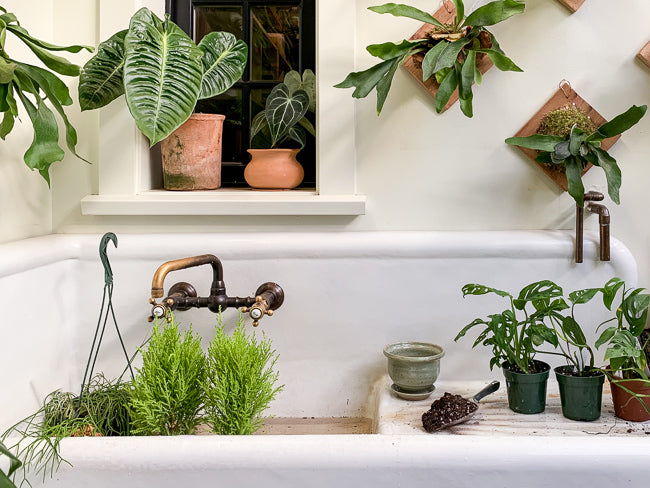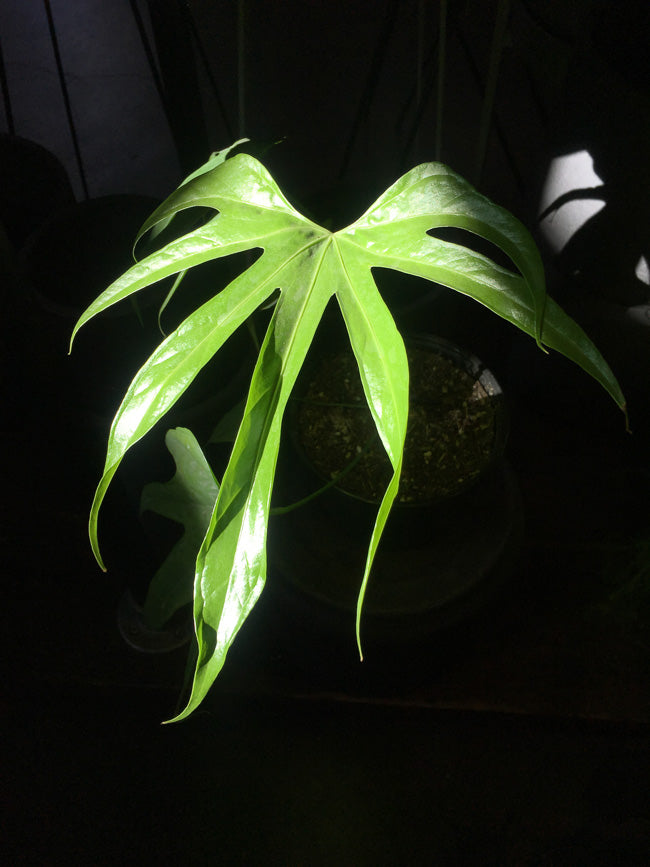There are three basic components that (most) house plants need to live a successful life: light, water and soil. Understanding when to water, how to observe available light, and what types of soil substrates to use is paramount to caring for our house plants. But how exactly do plants use these three components?

Plants make food using the sun’s energy, a process called photosynthesis. With sunlight, plants are able to convert carbon dioxide (from the air) and water (from the soil) into glucose, aka food. The plant uses water to siphon glucose throughout its system, while flushing out any excess minerals. Soil (along with other substrates) provides the base in which the plant's root structure is supported, and is where (terrestrial) plants soak up most of their water.
You might be saying to yourself, “How does water move up from the roots to the rest of the plant? Doesn’t that defy the laws of gravity??” Scientist mostly agree that this happens through a process called transpiration. As water evaporates from aerial parts (leaves, stems, and flowers) it causes a ‘pulling’ effect, allowing plants to bring water and nutrients up from the soil into the rest of the plant.
Now that you know the basics of how plants use light, water and soil, we can apply that knowledge to better care for our house plants.
Light, Water and Soil: A recipe for better house plant care
Light: We get a lot of light related questions in the nursery, and so we understand how mystifying it can be. Indeed, light intensity is the most essential element to get right to ensure a long life for your houseplants.

It is important to observe the quality of light coming into your home to better understand which types of plants will thrive and in which locations. West- and south-facing windows provide the highest amount light, while eastern exposures provides bright, diffused light. North-facing windows provide the least exposure and lowest light level.
This can of course change if there is something obstructing our windows and depends on what geographical region you are located. Look out your windows at different times of day to see whether the sun passes through it, or if there is only a brief period in which ambient light is bright. To understand if the light is direct, bright, or diffused, observe the shadows you cast -- the darker and better-defined your shadow appears, the brighter the light source.
Plants' light needs are also variable, and researching their natural habitats can give you an idea of what type of light you should provide. Succulents, especially desert cacti, are sun lovers and require at least 4 hours of direct sun exposure. Tropical plants' light needs vary quite a bit but generally cannot handle too much direct sun exposure.
Placement is key -- you might have to find a spot where a tender plant is both shielded from direct sun while at the same time exposed to bright ambient light. Distance from windows can also act as diffusion, so be careful not to place sun loving plants too far interior.
Water: It is essential to give your plants water after they have had exposure to the sun’s energy. The more light available, the more water the plant will need. The opposite is true as well -- this is why we water less in the winter than in the summer.

Plants have a variable need for water, and it is important to know where they reside naturally in order to provide the proper amount. In general, succulent plants have more water stored in their foliage and stems than thin-leafed tropicals. We can conclude that plants with more succulent (firm) leaves will prefer drying out more thoroughly before watering, whereas tropicals will to be watered more regularly.
When watering, it is important to evenly saturate the whole pot and allow for water to trickle out the bottom; this ensures the soil is evenly moist and all the roots have access. A good watering can makes this job a lot easier, because it will allow you to regulate the speed that water is hitting the soil. Watering slowly allows you to ensure that it's actually being absorbed into the soil, not just flowing down the sides and out the bottom of the pot.
We always recommend getting your fingers dirty to know when it's time to water. Dig 1-2" down in the pot and assess the moisture level; depending on what kind of plant you have, the level of dryness will tell you it's time to water. As a back-up, consider using a moisture meter -- a handy little device that can get deeper down in the pot to gauge moisture level.
Soil: Soil and other substrates support healthy root systems and allow for proper watering; some soil mixes will hold a lot of water and stay wet for long periods of time, whereas others will allow water to pass through easily and dry rapidly.
Once again, the origin of your plant will also dictate what type of substrate it prefers. Cacti and succulents from arid regions prefer fast draining, sandy, and rocky soils, whereas aroids and other big leaf tropicals will prefer bark-heavy mixes that allow large roots to grow with plenty of air, while holding moisture for longer periods of time.
Perhaps you don’t care to buy three different bags of soil - we don't blame you! An easy fix is to amending regular potting mix with various substrates to tweak the soil for each of your plants' particular needs. Perlite, horticultural charcoal, sand, pumice, orchid bark, and clay can be helpful amendments for a variety of reasons.
Feeding the soil itself (a separate topic from plant fertilization) is often overlooked as a method of care for your plants, but it would be a disservice to dirt if we didn't mention this. Soil science is a vast and wildly interesting topic... for some. Simply put, soil is a mixture of organic matter, minerals, gases, liquids, and organisms that together support life. It is an ecosystem that needs replenishing, especially when kept in a pot where it it is cut off from the vast diversity of the soil (worms, bugs, bacteria etc!). Occasionally feeding the soil with micronutrients can support healthier plants that are more resistant to stress and disease.
By: Amelia Ralston Okabayashi
